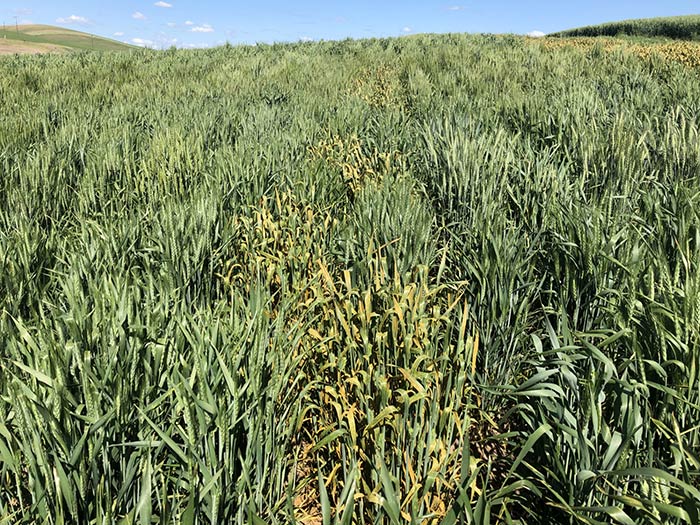
In the 2024 crop season, stripe rust started early and developed into a severe epidemic level in the Pacific Northwest. As early as Nov. 14, 2023, stripe rust was observed in a winter wheat field in Lincoln County, Wash. Due to the relatively mild winter of 2023-24, the fungal pathogen survived the winter and started developing very early in the spring. Active stripe rust appeared in that same field, another field in Adams County, and our experimental field in Walla Walla in late February of 2024. The widespread application of fungicides at the herbicide application timing largely kept the rust under control, except for a few fields that needed a late application of fungicides.
In our experimental fields around Pullman, Central Ferry, Walla Walla, Lind, and Mount Vernon, natural infection of stripe rust developed to epidemic levels (Figure 1). This allowed us to obtain reliable stripe rust data in the germplasm screening nurseries for supporting breeding programs to develop stripe rust resistant varieties and in other nurseries for assessing yield losses of commercially grown varieties and yield benefits of various fungicide treatments.
In 2024, we evaluated over 50 nurseries each consisting of 30 to over 1,000 wheat or barley entries. All nurseries were planted at the Palouse Conservation Field Station (for wheat) or the Plant Pathology Farm (for barley) near Pullman, Central Ferry, and Mount Vernon, and the variety trials and regional nurseries were also planted at the Spillman Farm near Pullman, Lind, and Walla Walla. In addition to the field tests, the variety trials and regional nurseries were tested in the greenhouse at both seedling stage under a low-temperature profile (39-68 F) and adult-plant stage under a high-temperature profile (50-86 F) with multiple races of the stripe rust pathogen to determine whether the entries have all-stage resistance (ASR) and/or high-temperature adult-plant (HTAP) resistance, the spectra of ASR, and levels of HTAP resistance. Table 1 summarizes the stripe rust ratings based on the field data and the levels of HTAP resistance based on the greenhouse tests of the Washington State University Wheat Variety Trials.
In general, varieties with ratings of 1 (most resistant) to 4, or in the categories of resistant (R) to moderately resistant (MR), should be selected to plant, while those with the ratings 5 to 9 (most susceptible), or in the categories of moderate susceptible (MS) to susceptible (S), should be avoided if possible. This data is also available for download from our stripe rust website at striperust.wsu.edu/nursery-data/2024-nursery-data/. Please find the file name of “24102_WEDN” for the Winter Wheat Variety Trial and the file name of “24202_SEDN” for the Spring Wheat Variety Trials on the 2024 nursery data page.
To determine yield losses for individual wheat varieties, 23 winter wheat and 23 spring wheat varieties were selected based on their planted acreages in the previous years. The selected varieties cover 72.2% of 2023 and 60.4% of 2024 winter wheat acreages, and 96.3% of 2023 and 94.2% of 2024 spring wheat acreages in Washington state. The winter wheat varieties, together with the stripe rust susceptible (S) check PS279, were seeded on Oct. 30, 2023, in an experimental field at the Palouse Conservation Field Station, and the spring wheat varieties, with the S check AvS, were seeded on May 1, 2024, in an experimental field at the Spillman Farm. The 24 varieties in each experiment were arranged in a randomized complete plot design with a split-block constraint, based on fungicide application, with four replications. Both fields were under natural infection of the stripe rust pathogen, and fungicide Quilt Xcel was applied at the rate of 14 fluid ounces per acre, mixed with 2.25% volume per volume M-90 (nonionic surfactant) in the sprayed plots twice with the first application at the early jointing stage (Feekes 5) and second application at the boot stage (Feekes 10). Application days were May 15 and May 30 for the winter wheat field and June 13 and June 28 for the spring wheat field. In the winter wheat field, stripe rust was 1-5% severity in the S check plots at the first fungicide application and developed to 25-40% severity in the nonsprayed check plots at the second application. In the spring wheat field, stripe rust was absent at the first fungicide application and reached 10-20% severity at the second application in the nonsprayed check plots. Stripe rust severity was scored for each plot four times from Feekes 5 to the soft-dough stage (Feekes 11).
The winter wheat plots were harvested on Aug. 2 and the spring wheat plot on Aug. 20. Grain yield and test weight were measured for each plot. The relative area under the disease progress curve (rAUDPC) was calculated for each plot based on the four sets of severity data, as a measurement of over-the-season stripe rust level. The rAUDPC, test weight, and yield were compared between nonsprayed and spray treatments for each variety, and their average values are presented in Table 2. The differences in these values between the treatments indicate the stripe rust damage and fungicide effect for each variety.
For example, the fungicide application reduced stripe rust rAUDPC by 90.4%, increased grain test weight by 5.2 pounds per bushel, and increased yield by 61.2 (127.8%) bushels per acre for the winter wheat S check. Similarly, stripe rust reduced test weight by 5.1 pounds per bushel and decreased yield by 52.6 (40.4%) bushel per acre for UI Magic. In contrast, many commercial winter wheat varieties (including SY Dayton, LCS Hulk, Resilience Cl+, M-Press, and SY Assure) did not have significant yield losses. The average yield loss of the commercial winter wheat varieties was 7.5%. The stripe rust damage was relatively low on spring wheat compared to that of winter wheat. The spring wheat S check had 29.6% yield loss, and the average yield loss of commercial spring wheat varieties was 4.5%. The results can be used to select stripe rust resistant varieties to grow and for making decisions for fungicides for individual varieties under different stripe rust levels.
During the 2024 crop season, we also tested the efficacies of 15 treatments involving four fungicides (Quadris, Tilt, Quilt Xcel, and Trivapro) on control of stripe rust. These experiments were in a similar way to the above yield loss experiments but with only the S check varieties to compare among the various fungicide treatments. In the winter wheat experiments, all treatments significantly reduced the over-the-season stripe rust level and increased the grain yield. The nontreated winter wheat check PS279 had grain yield of 49.8 bushel per acre, while the yields of fungicide treatments ranged from 61.8 (Quadris at 6.0 fl oz/acre applied at Feekes 5) to 104.4 bushels per acre (Tilt 4.0 at Feekes 5 followed by Trivapro 13.7 at Feekes 10). The fungicide treatments increased yield by 24-110% compared to the nontreated check. All treatments of two applications at Feekes 5 and Feekes 10
provided better control than the treatments of only the early and only the late application. The exception to this was the treatment of Trivapro at 9.4 fl oz/acre applied only at Feekes 5 was better than the treatment of Quadris at 6 fl oz/acre applied at both Feekes 5 and 10. Among the sole treatments at Feekes 5, Trivapro was better than the other fungicides. Among the sole treatments at Feekes 10, Quilt Xcel at 14 fl oz/acre was the best. Among the treatments at both Feekes 5 and 10, the treatment of Tilt (4 fl oz/acre at Feekes 5) followed by Trivapro (13.7 fl oz/acre at Feekes 10) produced the highest grain yield, and the next two best treatments were that of Trivapro (4 fl oz/acre at Feekes 5) followed by Trivapro (13.7 fl oz/acre at Feekes 10), and the combination of Tilt (4) and Quadris (6) applied at both Feekes 5 and 10. For detailed data go to the stripe rust website at striperust.wsu.edu/disease-management/fungicide-data/.
For the 2024-25 crop season, we have checked winter wheat fields in the early-planted areas in Washington. On Nov. 5, we found stripe rust in a field in Lincoln County. However, the rust fungus might not survive the winter as we did not find stripe rust in the same fields and in all other checked fields on March 4. In January, we predicted stripe rust to cause 41% yield loss on highly susceptible winter wheat varieties in 2025 based on the weather conditions in November and December of 2024. In March, the prediction dropped to 18% due to the cold period that occurred in February. According to this prediction, commercially grown varieties will likely have 0 to 13% yield losses, or 2.4% yield loss on average without fungicide application. Thus, fungicide application is generally not necessary in the early spring. However, growers still need to check their winter wheat fields. Once stripe rust is found, the fields should be sprayed with fungicides. For spring crops, stripe rust resistant or moderately resistant varieties should be planted. We will continue conducting field surveys and providing updates for managing stripe rust throughout the crop season. If you have any questions for stripe rust management, please contact me through email at [email protected] or [email protected] or by phone (office: 509-335-8086; cell: 509-432-5852).
This article originally appeared in the April 2025 issue of Wheat Life Magazine.

Xianming Chen
Research Plant Pathologist, U.S. Department of Agriculture, Agricultural Research Service
